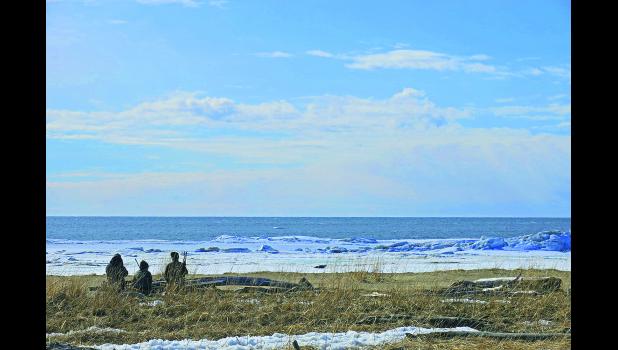Early spring makes for early subsistence harvests
For the first time in recorded history, Savoonga whalers landed their first spring bowhead whale in March. According to Savoonga’s representative to the Alaska Eskimo Whaling Commission George Noongwook, whaling captain Carl Pelowook Jr. and his crew landed the whale on Easter Sunday, March 27. The same crew landed another whale on April 5.
Noongwook reports that since then, strong winds and unfavorable weather conditions have kept hunters from going out to sea, but they are still geared up at their whaling camp at the southwest coast of St. Lawrence Island – about 40 miles away from Savoonga – to go whaling if weather and ice conditions permit. However, Noongwook said, there is hardly any ice left to conduct whaling and constant 25 to 35 mph Northeast winds have hampered their efforts. On the north side of the island, sea ice is abundant but jumbled up and it is impossible to find a trail through the jagged ice ridges by snowmachine with boats in tow.
Last year, Noonwook said, the whalers missed the whale migration because of bad ice conditions. This year, when the weather cleared and the ice allowed, the hunters were ready for an early start. As of press time, Gambell whalers did not land a whale.
Noongwook said, in order to have enough meat to get through the year, both Savoonga and Gambell need to catch eight whales each. Noongwook said that weather and ice conditions vary annually and became unpredictable. The unpredictability is compounded by to steep gas prices on the island, making it difficult for hunters to afford going back and forth to camp and making a sustained hunting effort nearly impossible. Although the bowhead whale population increased in numbers, it remains a challenge for hunters to get to the animals due to the increase in gas and fickle weather and ice conditions. “This is very stressful and unhealthy for our people,” said Noongwook. “We need to conduct the hunt to make our people happy.”
He said that when a whale is landed and distributed throughout the community for food, there is a custom of celebrating and dancing. Without a successful hunt, these joyful activities stop. “Without the food there is no celebration. That’s very unhealthy,” he said. Noongwook explained that stress from food insecurity, depression from unsuccessful hunts and anxiety how to deal with a changing climate and its ramifications are weighing the people down at times. “But then we try to keep it bearable with humor,” he said. “It’s not all bad.”
Due to changes in conditions, about 40 percent of the harvests of marine mammals are now done in the winter, whereas the traditional time to bring in the majority of food was in spring.
On the mainland, Kawerak Subsistence Director Brandon Ahmasuk reports that this year’s spring hunt is very early. People are out hunting seals and walrus, but encounter difficulty finding stable ice. “Ice conditions are really not stable, the ice is real thin,” Ahmasuk said. He reports from a personal hunting trip out in Norton Sound, the ice was so thin that his boat cut right through the icy slush instead of providing a stable platform to butcher animals on. Ahmasuk reports that two seals so far were seen with bald spots, similar to the mysterious seal disease that erupted in 2011/2012 where hundreds of seals were observed bald, with weeping sores and unusual tame behavior. Despite a federally declared Unusual Mortality Event investigation, no cause has been found yet that could explain the seal disease. The two seals reported recently were hairless, but were reportedly fat and showed no signs of open sores. Ahmasuk reports that on the southside of Sledge Island, he saw murres, sea gulls, auklets and cormorants. “That’s about two months early for especially the murres and cormorants to show up,” he said.
Bill Dunker, biologist with the Nome office of the Alaska Dept. of Fish and Game, reports that the low snow coverage this winter had a positive effect on ungulates, namely moose and caribou. “Moose and Caribou appear to be in excellent body condition and surveys conducted this spring indicate that both species have excellent recruitment,” Dunker wrote in an email to the Nome Nugget. He also noted that since early November, approximately 77 percent of the Western Arctic Caribou herd has wintered on the Seward Peninsula. The herd was found further west than previously recorded and was accessible to a number of hunters on the Seward Peninsula. “At this time the herd has begun to move north towards the calving grounds, some of which crossed large expanses of sea ice enroute to areas around Kotzebue,” Dunker wrote.
Dunker also reports that bears are being harvested throughout the Seward Peninsula as well as a significant number of wolves. As of April 27, 60 wolves and 8 bears have been harvested from Unit 22, Dunker said.
He also reminds outdoors travelers that they may come upon orphaned wildlife. “We would like to remind the community that no one, except the ADF&G and the Alaska Wildlife troopers, is authorized to take orphaned wildlife into possession,” he wrote. “If you do come across orphaned wildlife, do not touch, handle or pick up any animal or bird, instead, report the location, type and behavior of animals that appear orphaned to wildlife officials.”

